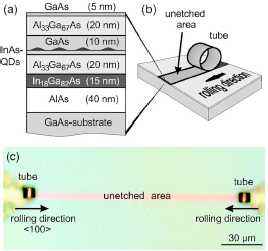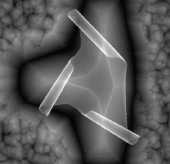| Posted: Apr 11, 2006 | |
Quantum dots in a tube could open a new chapter in opto-electronics |
|
| (Nanowerk News) Researchers in Germany managed to integrate quantum dots (QD) into the walls of nano- and microtubes. This novel structure serves as a quantum light emitter as well as optical waveguide. This represents a major step toward the realization of flexible high quality factor optical resonators based on tubes. | |
| The German group's findings actually consists of two distinct achievements: Firstly, they managed to coax a layer of a single material to roll up into a nanotube; and secondly, they incorporated quantum emitters into similar tubes. | |
 |
(a) Molecular beam epitaxy sequence for the fabrication of rolled-up tubes containing InAs QDs as quantum emitters in the tube walls; (b) schematic of a tube rolled up from a lithographically defined strained stripe; (c) corresponding light microscope image. The strained stripe pink is rolled up into tubes on both sides. The number of rotations 2.5, length 8 µm, and location of the tubes can be tuned by lithographic means. (Reprinted with permission from the American Institute of Physics) |
| "The incorporation of quantum emitters into the wall of semiconductor micro and nanotubes – acting at the same time as waveguides – is generic and independent of any material system" says Dr. Oliver Schmidt, "for instance, it can also be done with silicon. Our technology could well open up a new chapter in opto-electronics." | |
| Schmidt is head of the Molecular Beam Epitaxy Group at the Max Planck Institute for Solid State Research in Stuttgart/Germany. The group's recent findings, titled | |
| >"Light emission and wave guiding of quantum dots in a tube" were published in the March 13, 2006 edition of Applied Physics Letters. Lead author of the article was Dr. Stefan Mendach, a member of Schmidt's group. | |
| Schmidt recently presented results on the formation and properties of rolled-up nanotubes at the 2006 APS Spring Meeting's session on Nanomechanical Architecture of Strained Thin Films. He reported that thin solid films can be partially released from a substrate surface by selective underetching and then forms into various 3D micro- and nano-objects. This technique opens the way to realize and integrate ultra-compact coils, transformers and capacitors on a single chip, ultimately leading the way to all-silicon nanotubes on silicon chips. Schmidt's presentation was the topic of a "News Focus" in the March 31, 2006 issue of Science. |  |
| Si-based rolled-up nanotubes. (Source: O.G. Schmidt, Max-Planck-Institute for Solid State Research) | |
| A single quantum emitter is the ultimate limit of a light source, emitting photons one by one. Quantum emitters are required for applications in optical quantum technology and therefore have been subject to vast interest from scientists. | |
| One of the important criteria taken into account when evaluating the quality of a single-photon source is quantum indistinguishability, which depends on the radiative lifetime of the emitter. | |
| The Purcell effect predicts that the radiative lifetime of a quantum emitter can be decreased significantly below the dephasing time (bringing the emitted photon pulses closer to the Fourier transform limit) by coupling it to a high density of optical states. This effect can be achieved by embedding the emitter inside an optical nano- or microcavity, and it is of importance for construction of sources of indistinguishable single photons with high-efficiency and speed. | |
| The so-called "quality (Q) factor" of a mode is a measure for the finite photon lifetime in a real system and indicates the amount of resistance to resonance in such a system. The average lifetime of a resonant photon in the cavity is proportional to the cavity's Q. | |
| Research has shown that record Q values could be realized in silica microcavities. However, at present, Q factors for similar structures that at the same time provide quantum emitters are well below this value due to losses induced by surface roughness. To get around this problem, optical resonators with ultrasmooth surfaces based on self-rolling strained layers were proposed. | |
| In their recently reported research, the German scientists perform two important steps toward the realization of high-Q flexible optical resonators based on self-rolling strained InGaAs/GaAs layers. | |
| "First" says Schmidt, "we integrate self-assembled InAs QDs as quantum emitters into microtube walls. By microphotoluminescence (µ-PL) investigations, we show that the QD emission signal from the strained layers increases when rolled up into tubes." | |
| "Besides the availability of quantum emitters, we can also observe waveguiding in the rolled-up tubes" adds Schmidt, "an indispensable ingredient for any on-chip optoelectronics". However, the actual intensity distribution of the light at the tube ends is not identical for all investigated tubes and further experiments are needed to fully understand this phenomenon. | |
 By
Michael
Berger
– Michael is author of three books by the Royal Society of Chemistry:
Nano-Society: Pushing the Boundaries of Technology,
Nanotechnology: The Future is Tiny, and
Nanoengineering: The Skills and Tools Making Technology Invisible
Copyright ©
Nanowerk LLC
By
Michael
Berger
– Michael is author of three books by the Royal Society of Chemistry:
Nano-Society: Pushing the Boundaries of Technology,
Nanotechnology: The Future is Tiny, and
Nanoengineering: The Skills and Tools Making Technology Invisible
Copyright ©
Nanowerk LLC
|
|
Become a Spotlight guest author! Join our large and growing group of guest contributors. Have you just published a scientific paper or have other exciting developments to share with the nanotechnology community? Here is how to publish on nanowerk.com.
